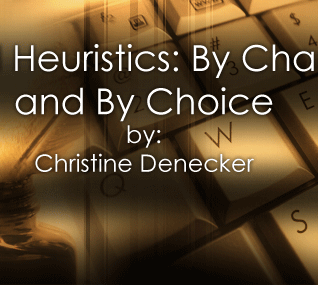


Heuristic Redesigned "Working in Power Point really helped me find my focus." In her 1977 article, Writing as a Mode of Learning, Janet Emig argues that the act of writing, in and of itself, has heuristic value. Drawing from the works of Jerome Bruner and Jean Piaget, Emig offers three key elements that converge during the writing process that spark investigation, exploration, and ultimately, learning: first, the best learning is “enactive”; second, it is “iconic”; and third, it is “representational or symbolic” (1977, p. 10). As Emig explains, writing affords all three in that the writer is actively composing with his hand, reading “icons” or “images” (for Emig, alphabetic “images”) with his eyes, and then restating thoughts into words cognitively—and all three functions “are simultaneously or almost simultaneously deployed” (1977, p. 10). Emig then theorizes that “If the most efficacious learning occurs when learning is re-inforced, then writing through its inherent reinforcing cycle involving hand, eye, and brain marks a uniquely powerful multi-representational mode for learning” (1977, p. 10).The same can be said for digital heuristics. Similar to the alphabetic writing Emig refers to, invention work in digital environments demands active involvement (students working at computers), the use of icons (here, visual images), and then a restatement of thoughts into the digital—all happening concurrently. However, the digital heuristic takes Emig’s theory one step further in that it can then act as a springboard into the alphabetic (the subsequent written assignment). Specifically, the movement from the digital to the written might constitute a type of “code switching” as described in the New London Group’s Multiliteracies: Literacy learning and the design of social features (2000), since digital heuristics challenge students to navigate between visual and traditional literacies. According to the New London Group, this ability to “code switch” constitutes a central skill in the learning process and in the expansion of literacy to include a plurality of cultures and texts (including multimedia texts). Gunther Kress and Theo van Leeuwen might call this “code switching” a “mapping” of meaning “across different semiotic modes”, since communication can be read and composed “either visually or verbally” (1996, p. 2). Furthermore, if one form of communication is not privileged over another, a greater possibility of creativity—that which is “innovative and transformative”—occurs (Kress, 2003, p. 186). Taken together, these theories suggest that it behooves instructors to design efficacious pedagogies that challenge students to:
The New London Group encourages educators to create such pedagogical designs and to study, specifically, how these designs “motivate and achieve different sorts of learning” (2000, p. 19). The Group also provides a blueprint for such creations in its Theory of Design, which includes the elements of Available Designs, Designing, and The Redesigned. Used progressively, these three elements “emphasize the fact that meaning-making is an active and dynamic process, and not something governed by static rules” (2000, p. 20). Creativity, engagement, and flexibility underscore this theory and are among its outcomes as well. And while the Group utilizes the Theory of Design to build its argument for the understanding and acceptance of a pedagogy of multiliteracies, the theory applies just as well to the inception and development of any number of student-centered pedagogical practices—and composition pedagogy is no exception. According to the Theory of Design, Available Designs include the resources for design; so in terms of digital heuristics in general, heuristics and technologies are the two Available Designs. Specific to the digital heuristic activity described in this article (see “By Choice”), the Available Designs consist of visuals, audio, technology, and a sample of a literacy montage. According to the New London Group, “Available Designs also include another element: the linguistic and discourse experience of those involved in the Designing, in which one moment of Designing is continuous with and a continuation of particular histories” (2000, p. 21). Thus, those creating the Design might bring a number of “histories” to bear: in this case, the language of rhetoric, insight into multiple intelligences, and a philosophy of student-centered pedagogy. Again, in a general application to digital heuristics, this suggests that an instructor’s various “histories” coupled with the Available Designs might yield a new design: a digital heuristic. A truly well structured digital heuristic, in turn then, must not only use the Available Designs (here: visuals, audio, technology, literacy montage sample) but also draw on students’ knowledge of technology, the writing process, and the topic at hand (here: shared literacies) in order to utilize the resources most effectively.
|